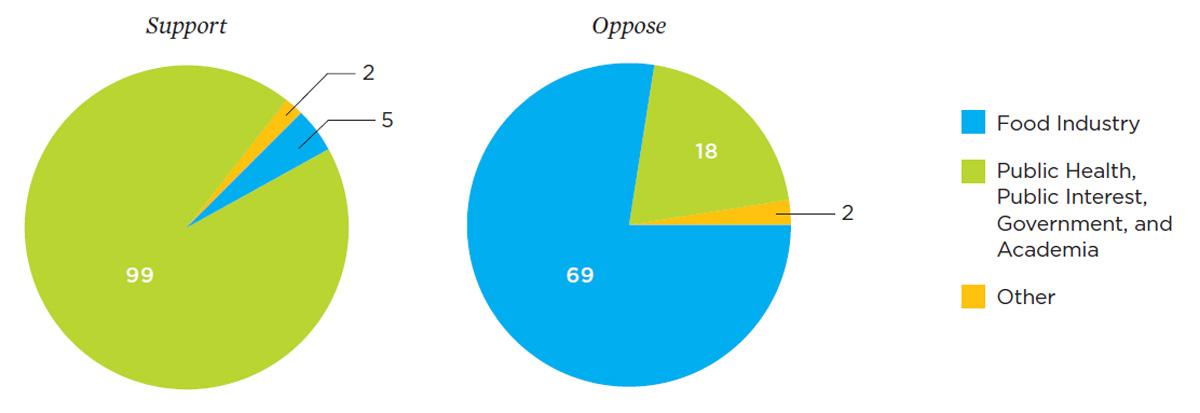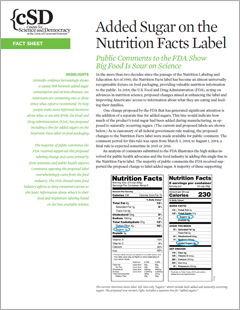In the more than two decades since the passage of the Nutrition Labeling and Education Act of 1990, the Nutrition Facts label has become an almost universally recognizable fixture on food packaging, providing valuable nutrition information to the public. In 2014, the U.S. Food and Drug Administration (FDA), acting on advances in nutrition science, proposed changes aimed at enhancing the label and improving people’s access to information about what they are eating and feeding their families.
One change proposed by the FDA that has generated significant attention is the addition of a separate line for added sugars. This line would indicate how much of the product’s total sugar had been added during manufacturing, as opposed to naturally occurring sugars. (The current and proposed labels are shown at right.) As is customary of all federal government rule making, the proposed changes to the Nutrition Facts label were made available for public comment. The comment period for this rule was open from March 3, 2014, to August 1, 2014; a final rule is expected sometime in 2015 or 2016.
An analysis of comments submitted to the FDA illustrates the high stakes involved for public health advocates and the food industry in adding this single line to the Nutrition Facts label. The majority of public comments the FDA received supported the proposed change to label added sugar. A majority of these supporting comments came from scientists and public health experts, while a majority of comments opposing the label came from the food industry.
The science on added sugars
Though not physiologically or metabolically different from naturally occurring sugars, added sugars are predominantly found in highly processed foods. Unlike fruits, vegetables, nuts, whole grains, and other nutrient-rich foods, processed foods typically do not promote satiety, even when fortified with vitamins and minerals, and can lead to increased consumption. Excessive sugar intake does not typically occur from eating too much fruit with naturally occurring sugars but rather from the consumption of sugar-sweetened beverages and processed foods that contain an abundance of added sugar.
Sugar consumption has long been known to cause tooth decay, and a growing body of scientific research now also finds evidence of a causal relationship between excessive sugar consumption and both weight gain and the rise in the incidence of major chronic metabolic diseases (e.g., type 2 diabetes, cardiovascular disease, high triglycerides, hypertension). Today, 25.8 million people in the United States are afflicted with type 2 diabetes, and 16 million suffer from heart disease. Overconsumption of sugar also has been linked to nonalcoholic fatty liver disease, which can lead to inflammation and scarring of the liver.
Approximately 31 percent of adults and 13 percent of children have this condition, which can progress to nonalcoholic liver cirrhosis, a life-threatening condition that can require a liver transplant. People in the United States face the additional burden of rising health-care costs associated with treating these conditions.
Amending the Nutrition Facts label to list added sugars is supported by science-based guidance from leading health organizations including the American Academy of Pediatrics, American Heart Association, Institute of Medicine, and World Health Organization, all of which have advised limiting added sugar consumption.

Food industry opposition
Since an estimated 74 percent of packaged foods contain added sugars, bringing attention to added sugars is likely seen as a threat to the bottom line of many food industry entities, many of which opposed the FDA’s proposed label change. Packaged food manufacturers (e.g., General Mills) and their trade associations (e.g., the Grocery Manufacturers Association) have mounted an intense campaign to block the proposed change to the Nutrition Facts label. Instead of acknowledging the scientific evidence linking added sugars to health problems, food industry comments to the FDA opposing the added sugars label repeatedly attempt to cast aspersions on the science and manufacture doubt (see the table below). These actions undermine measures that would benefit public health.
Added sugars and the 2015 Dietary Guidelines for Americans
In February 2015, the Dietary Guidelines Advisory Committee (DGAC) released a much-anticipated report outlining the latest scientific evidence for what people should be eating to stay healthy. The DGAC is an independent body of experts tasked with reviewing the research and making recommendations to the U.S. Department of Agriculture (USDA) and U.S. Department of Health and Human Services (DHHS) as these agencies develop the 2015 Dietary Guidelines for Americans.
When it came to added sugars, the DGAC found moderate to strong evidence for an association between high added sugar consumption—especially in the form of sugar-sweetened beverages—and tooth decay, obesity, type 2 diabetes, and heart disease. The report recommends limiting added sugars to 10 percent of daily calories (about six teaspoons for women and nine teaspoons for men)—far less than the 19.5 teaspoons per day (or 66 pounds per year) that the average person typically consumes.
The DGAC’s report takes an even stronger position on listing added sugars on the Nutrition Facts label than the FDA’s proposed rule. The DGAC recommends not only labeling added sugars on a line separate from total sugars but doing so in both grams and teaspoons (a teaspoon equals 4.2 grams), since teaspoons are easier to understand for most people, and listing the percent daily limit. For decades, the food industry has influenced federal nutrition and agriculture policies, often to the detriment of public health. The strong response from the food industry to the FDA’s proposed rule, and the misinformation about added sugars included in many of the industry’s submitted comments, underscore the uphill battle agencies face in implementing science-informed policies. It is critical that the FDA, DHHS, and USDA resist attacks on the science, ignore misinformation from powerful industry interests, and heed the recommendations from leading scientists and nutrition experts. Addressing added sugars in the Nutrition Facts label and 2015 Dietary Guidelines for Americans would mean a real victory for public health.
Methodology
The data used for this analysis were the comments submitted to the FDA in response to its proposed changes to the Nutrition Facts label during the public comment period, March 3, 2014 to August 1, 2014. The FDA received a total of 287,874 comments, of which approximately 516 were unique; of these, 257 contained the word “sugar.” Excluding from this subset duplicate comments and comments that did not actually mention “added sugar” at any point, 215 comments were included in the analysis, representing approximately 35,507 submissions on the topic of added sugar. Comments that casually mentioned added sugars in relation to an unrelated point were included but were not considered substantive. Opinions on added sugars were categorized as “support,” “oppose,” or “no stance”; the figure on p. 2 shows a detailed breakdown of these responses.




